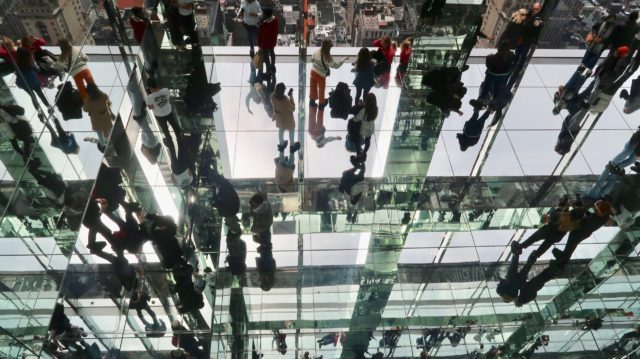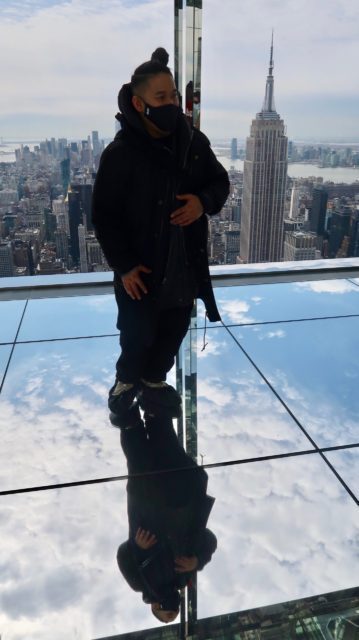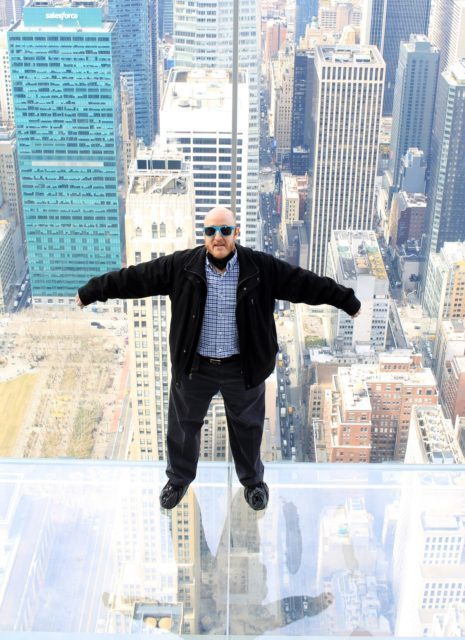
Kenzo Digital’s Air offers a new perspective on making connections in the city (photo by twi-ny/mdr)
AIR
SUMMIT One Vanderbilt
45 East Forty-Second St. at Vanderbilt Pl.
Admission: $39-$73
summitov.com
kenzodigital.com
online slideshow
“I wanted New Yorkers to come and watch their home come back to life, to reengage with their friends and family they hadn’t seen for a long time and create ritual and ceremony around human connection, which is actually the antithesis of New York, which is a highly transactional city where people are just trying to survive,” Kenzo Digital said on a private walkthrough of his multipart permanent installation, Air, near the top of the SUMMIT One Vanderbilt skyscraper. “So I want to have a place where people can forget about that aspect of their survival identity in New York and connect through a primal curiosity on a basic, authentic level.”
Kenzo, a graffiti artist, DJ, and film and video director who has worked with Kanye West and Beyoncé, had lofty goals when designing Air; he didn’t want the project to just be an Instagram-friendly tourist attraction but to generate other, more meaningful conversations, especially among New Yorkers.
“In a nutshell, what I wanted to do was essentially create an experience of physical space that was capable of having a deep emotional and psychological relationship with a human being over the course of their entire life. The idea is you walk into this space and it will feel different every time,” he explained. “I wanted to create something that specifically challenges and defies language, both the written word and the image. It’s impossible to describe what this is, even though you can break it down by its components and you’d be correct, but it’s impossible to describe the effect of the experience and the emotional impact. Everyone is wrong and right in different ways, and it will be a different wrong and right every time you come.”
Air consists of several floors of fantastical views of New York City and dramatic reflections, reaching high into the sky and way down below, of the humans occupying the space on the ninety-first floor and above. “We built the entire thing during the pandemic. It was like making art in a science fiction film. It was . . . fucking crazy,” Kenzo notes. Glass windows and mirrors are arranged in geometric patterns that result in awe-inspiring repeated imagery that forces visitors to try to find their body in the space as well as their position in the city and the world. Kenzo, whose previous installations include Social Galaxy, which featured chambers where visitors were barraged by their social media history, and the immersive haunted house Nocturnal Awakening, considers the work to be “the story of your relationship to time, your relationship to New York City, your relationship to weather, and also your relationship to yourself.
“It’s about the relationship between the natural world and the physical world,” he points out. “If there is an approaching storm from New Jersey, you will see the city as an organism react to that storm — cars, traffic, people move differently, with rain on the street, fewer people, umbrellas pop up. You can see the city as an expression of nature. People always talk about the life force of New York; Air is an organ within that life force, the heart of it that contains its spirit. This is expressing the infinite power of chaos that is the collision of uncontrollable variables: nature, time, the world, your emotions, your place in all of this.”
Visitors first take an elevator that recalls one of Yayoi Kusama’s Infinity rooms, with lights flashing on and off and mirrors that reflect the passengers into an endless oblivion. You get out at “Transcendence,” a large rectangular space with tall windows that offer stunning views of the city on three sides and glass floors that reflect the inside and the outside. It will take you a while to orient yourself, especially as you look down at what appear to be multiple levels of people either upright or upside down as buildings, blue sky, and clouds merge with the interior space.
“There are so many avenues, it almost looks like they’re delivering you to the front doorstep of One Vanderbilt,” says Kenzo, who speaks quickly and excitedly, like a child with a new toy. “And because it’s positioned so symmetrically, you can almost see the city like an organized system of neighborhoods; you understand it spatially, you understand the grid, and that grid is magnified and deconstructed within the grid of reflection that exists in here.” The gridlike structure recalls the multimedia installations of the father of digital art, Nam June Paik, who arranged television sets into wholly new, living environments; Kenzo is the late Nam June’s great-nephew and the creative director of his great-uncle’s estate.
Much of the eye contact in Air is made via the reflections, so you can connect with individuals who are not in your immediate physical space, if you can find them. It’s a far cry from being on the subway, for example, where many straphangers go out of their way to avoid eye contact with anyone.
When I mention to Kenzo that it’s hard to tell who is actually on the mezzanine and what are reflections, he replies slyly, “They are asking themselves the same question about you.”
In the mezzanine, you can look down and see how the next batch of people initially react to the area. Kenzo explains, “The idea behind Transcendence II is this concept of folding time in the sense of that when you’re up here, you’re essentially watching people exposed to the concept for the first time, and so the idea of connective language through primal curiosity is in effect because you see people, just where you were a few minutes ago, processing the information at a base level for the first time. So as we were just down there, observing that there’s a physical mezzanine up here and making eye contact, everyone up here has already established equilibrium and has the foundation of knowledge and information, and everyone down there is still figuring out what’s going on.” Kenzo envisions Air as encompassing human development: “crawl, walk, run, fly.”

Kenzo Digital stands next to the Empire State Building in his permanent installation at Summit One (photo by twi-ny/mdr)
The idea for Air emerged from Kenzo’s subconscious.
“This is all based on a recurring dream I’ve had for twenty-five years; it’s a strangely, deeply personal thing,” Kenzo reveals. “In the dreams there’s a fictitious skyscraper, residential; so I’ve had these dreams that took place in the top two floors, the penthouse of the skyscraper, which is circular in shape, which is why I have the two circles on the east and west side as a nod to that dream. So it’s the ability to project my dream and then put it inside of other people’s mind and then for that to be a shared dream. And oftentimes I find people dream about it after the experience.”
Affinity is a room of silver balls, reminiscent of Andy Warhol’s helium Silver Clouds, that visitors can run through, kicking the balls in the air and against mirrors and windows, each ball reflecting themselves, those around them, the view, and other balls as dozens of orbs seem to multiply into thousands in a fun deluge. “It’s constantly engaging with the city; it’s always an inside-outside experience,” Kenzo says. In another room, the inside-outside connection involves a projection of sky and clouds on the wall and the floor as scanned images of your face are added to a large screen.
Levitation puts you in a space where you are seemingly floating above the skyline, standing on a transparent floor facing a window so clear that it makes you feel like it’s not there, that you are on a ledge, midtown Manhattan right below you. Cameras are set up to take a picture and/or video of you in the space that you can pick up at the exit. As wondrous as it is to look at, it also makes you feel the interdependence between nature, technology, and humanity as well as the impermanence of life. “It’s the story of your relationship to time, your relationship to New York City, your relationship to weather, and also your relationship to yourself,” Kenzo explains. You can further those relationships by taking the outside glass elevator, Ascent.

Levitation offers a chance to seemingly float above New York City (photo courtesy Summit One)
Kenzo honors Japanese artist Kusama with her 2019 work Clouds, a collection of amorphous stainless-steel and wax floor sculptures that also reflect visitors and the sky; it is the first of a rotating series of exhibitions Kenzo will curate by other artists in the space.
Kenzo sees Air as an ever-changing, always-evolving experience that changes from day to day, hour to hour, depending on the crowd and the weather, and he wants it to be more than just a photo opportunity that’s over when you leave.
“There’s a part of you that stays in here,” he says thoughtfully.